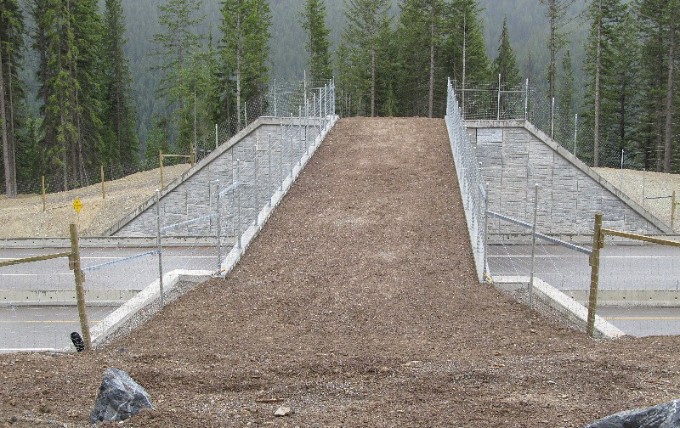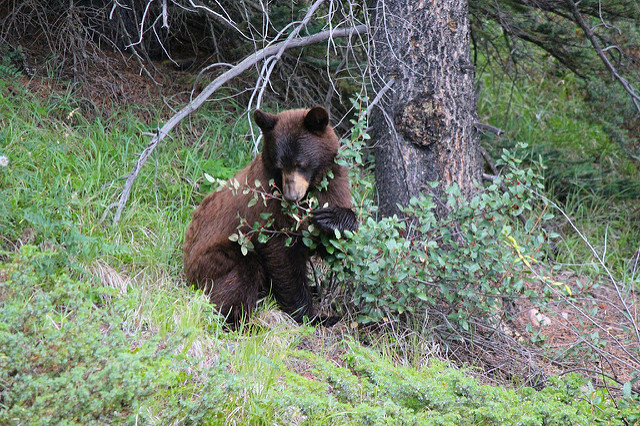Last year a terrible accident in India made headlines around the world. Late one February night, a speeding train struck a herd of elephants crossing the tracks, instantly killing two adults and two calves. A third adult died soon after.
It wasn’t an isolated incident. Over the past 30 years train collisions have killed more than 220 elephants in India alone.
Most of those incidents don’t generate international headlines; nor do the deaths of thousands of additional animals killed by trains worldwide each year. In fact most wildlife-train collisions go unnoticed, their fatalities left uncounted — which has made it difficult for experts to study the problem and mitigate its impacts.
That puts us woefully behind similar research to reduce vehicle-wildlife collisions on roads, an active field of research for the past two decades. That’s because car-animal collisions present a greater danger to human safety and property, according to a 2016 study surveying the emerging field of railway ecology. “Despite the field of road ecology rapidly expanding and the large footprint created by railways, there is a prominent lack of research related to railways and their effects on wildlife,” the study found.
Here’s what we do know: Like roads, railways fragment habitat and can affect all kinds of wildlife in varying ways. Collisions are the most common cause of mortality, but some animals die from electrocution or being stuck between the rails, leaving them susceptible to predation, starvation or dehydration.
Exactly how many animals die is a bit of a mystery. Railway mortalities are usually not as visible to the public as roadkill, and railways can be harder to access for research and data collection, the 2016 study found.
The little research that has been done on railways and wildlife has been largely limited in both scope and geography. The majority of studies have looked at large mammals, mostly in North America and Europe, with some attention paid to elephant strikes in India.
“The mammal species receiving the most attention are frequently the larger ones, such as moose, bears or elephants as they cause more damage to trains, disrupt the normal operation of the train network, or hold higher conservation and economic status,” according to the editors of the 2017 book Railway Ecology.
Understanding how to curb wildlife deaths from trains means first understanding what draws animals to the tracks in the first place, which is not always easy. New research is working to close that knowledge gap, identify problem areas and find cost-effective solutions.

The timing of this research, experts tell us, is important. With rail transit of products and materials on the rise and high-speed rail networks expected to grow as we work globally to lower our carbon footprint, the number of fatalities could soon increase unless we devote more resources to additional research and mitigation.
Railway Barriers
Rail tracks can make for tough times if you’re a toad — even a big one.
In Brazil a 2018 study found an estimated 10,000 Cururu toads (Rhinella marina) and related species, often called giant toads, were dying every year along a 500-mile stretch of railway. Researcher Rubem Dornas says they still don’t know exactly why so many toads die, but it appears the tracks formed a barrier the toads can’t cross while migrating. Despite the large size of the toads, which average about 4 to 6 inches in length, the researchers found they may not be able to jump or climb over rails more than 6 inches high.
“We think the main problem is the barrier effect caused by the rails,” says Dornas.
Not all the fatalities are the result of being run over by passing trains. Some of the toads appeared to have died from desiccation due to extreme heat from the tracks.
Most horrifyingly, others showed signs of barotrauma, where a sudden change in air pressure from the fast-moving train causes the inner organs to be blown out — the toads literally exploded from the inside.
While additional research would help to better understand the problem and its population-level impacts for the toads, Dornas says that providing passage underneath the rails could be a useful solution.
A 2018 study of endangered gopher tortoises (Gopherus polyphemus), which have been known to cross railways near John F. Kennedy Space Center in Florida, came to a similar conclusion.
“We predict that nearly all tortoises in the vicinity of railways are susceptible to becoming entrapped or experiencing reduced movement and dispersal,” the researchers wrote. They recommended trenches that can create a safe passage underneath the tracks and an escape route for those that get caught between rails.
While smaller in size, these trenches are similar in concept to corridor bridges and tunnels that are commonly used to help animals safely cross roadways. And while crossing structures may be used occasionally for railways — like a “landscape” bridge over railway tracks that was opened in Stockholm, Sweden in 2017 — it’s far less common. The biggest reason is simply financial — the structures take resources to build, and so far more investments have been devoted to reducing wildlife collisions on roads than rails.

That could change with more interest in railway ecology and cheaper building options. ARC Solutions, a project of the Center for Large Landscape Conservation, held a recent design competition to rethink the materials and engineering used in wildlife overpasses to make them more sustainable and affordable. If those concepts come to fruition, it could mean an easier lift to develop safer crossing systems for all kinds of wildlife over both roads and rails.
Warning Systems
Getting animals over or under tracks safely is helpful when a railway is an obstacle. But, as researchers found in Alberta, Canada, railways can also be a destination. And that requires a new set of solutions.
Concern over grizzly bear (Ursus arctos) deaths on the Canadian Pacific Railway between Banff and Yoho national parks has prompted years of study. “The causes for attraction of bears to the rail are really surprisingly complex and variable among individuals,” says Colleen Cassady St. Clair, a professor of biological sciences at the University of Alberta, who has been leading a team to determine why grizzlies end up on railways and how to prevent their deaths. “There just isn’t a single simple solution.”
The biggest reason is that railways are a good place for a bear to find food. For one thing, the trains can spill grain from their cargo cars, leaving behind a steady supply of free food.
The very existence of the railways also opens up avenues for grizzly dining. The carcasses of deer and other ungulates struck by trains are an attractant for bears. Railways are slightly warmer than adjacent forests, which attracts ants, another grizzly food, researchers have found. And palatable vegetation also grows along the tracks, providing grizzlies with a wide range of edible choices.
This “edge habitat,” according to a 2017 study co-authored by St. Clair, has “higher species richness, diversity and cover for seven of the eight most commonly-occurring species that are consumed by grizzly bears.” Buffaloberry, a local fruit that’s an important source of nutrients for bears pre-hibernation, was even found to have more fruit, ripen earlier and have higher sugar content within 15 meters the railway lines compared to the nearby interior forest.

More food along railways means the possibility of more train strikes on bears. So what to do about it?
One tactic would be to limit the growth of vegetation that attracts bears and other wildlife, or, as Canadian Pacific Railways has done, remove vegetation from along the tracks that could obscure sight and sounds lines to make approaching trains easier to see and hear at certain problem locations.
But St. Clair favors a different approach, developed by one of her graduate researchers, Jonathan Backs. He invented a warning system using a vibration sensor on the track that, farther down, triggers a ringing bell sound and flashing light 30 seconds before a train passes by a hotspot that has been designated for mitigation.
Acoustic warning systems have been developed elsewhere. Poland is testing a system that deters wildlife from approaching trains by loudly broadcasting recordings of barking dogs and alarm calls of other animals. Japan is testing a similar system. St. Clair says that these acoustic warning systems are promising, but it’s too early to determine how effective they’ll ultimately be. One drawback could be that if predator sounds are used as a deterrent and no predator ultimately appears, animals will stop associating those warning sounds with a risk.
To avoid that potential pitfall, the warning system that Backs is developing in Alberta has a key difference: It’s not meant to scare the animals, but to teach them.
“Our idea with this approach was to help the animals learn that these warning signals, which are not scary in themselves, are reliably associated with the train coming, which most animals seem to find scary,” says Backs. “And then the animals would learn to get out of the way when they receive these warning signals rather than waiting for the train to arrive.”
Backs says he’s still analyzing the data he has collected from trials of the warning system, but preliminary results are encouraging — and not just for bears. Other large animals appear to leave the tracks around six seconds earlier when the system is used.
And that’s another reason St. Clair is excited about the potential of this system. Public interest in grizzlies helped spur the research, but the mitigation can be useful for all kinds of wildlife and all over the world. “The principles potentially apply to all animals,” she says.
Backs says there is still more work to do to prove the concept and then find partner organizations to implement it. “The most important thing for me is to get it out there and make it real and put it in the hands of people who are working hard to keep animals safe,” he says. “It might end up being only one part of a broader toolbox — different solutions are appropriate in different situations — but it’s exciting that this could actually be used to save lives.”
And for the field of railway ecology, more research is still needed, too, says St. Clair.
“We need a broader understanding of where mortality is a real problem, for which species and what the circumstances are that generate locations of higher vulnerability,” she says. “Some ongoing work in Banff is trying to put together an entire database of animals that have been killed on the rail and determine what environmental and train operational factors seem to contribute to that vulnerability. With that information it will be possible to be more surgical, if you will, in applying the right kind of mitigation.”
![]()


